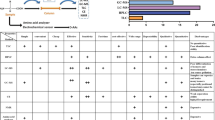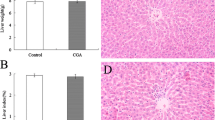Summary
Eleven neutral amino acids and two acidic amino acids in tissue proteins of mouse kidney, liver and brain were analyzed for the presence of D-enantiomers. The proteins were hydrolyzed with HCl for 6 h. Of the thirteen amino acids investigated, the presence of D-enantiomers of serine, alanine, proline, aspartate and glutamate (including asparagine and glutamine) was shown in the hydrolysates. However, the level of D-enantiomers were not significantly higher than that of 6-h hydrolysate of serum albumin examined as a control protein. Serum albumin was shown to contain no D-amino acid residues.
Similar content being viewed by others
References
Broccardo M, Erspamer V, Falconieri-Erspamer G, Improta G, Linari G, Melchiorri P, Montecucchi PC (1981) Pharmacological data on dermorphins, a new class of potent opioid peptides from amphibian skin. Br J Pharmacol 73: 625–631
Helfman PM, Bada JL (1976) Aspartic acid racemization in dentine as a measure of aging. Nature 262: 279–281
Marfey P (1984) Determination of D-amino acids. II. Use of a bifunctional reagent, 1,5-difluoro-2,4-dinitrobenzene. Carlsberg Res Commun 49: 591–596
Masters PM, Bada JL, Zigler JS (1977) Aspartic acid racemisation in the human lens during ageing and in cataract formation. Nature 268: 71–73
Meister A, Wellner D (1963) Flavoprotein amino acid oxidases. III. D-Amino acid oxidases. In: Boyer PD (ed) The enzymes, vol 7, part B, Academic Press, New York, pp 634–648
Nagata Y (1992) Involvement of D-amino acid oxidase in elimination of D-serine in mouse brain. Experientia 48: 753–755
Nagata Y, Akino T, Ohno K, Kataoka Y, Ueda T, Sakurai T, Shiroshita K, Yasuda T (1987) Free D-amino acids in human plasma in relation to senescence and renal diseases. Clin Sci 73: 105–108
Nagata Y, Konno R, Yasumura Y, Akino T (1989) Involvement of D-amino acid oxidase in elimination of free D-amino acids in mice. Biochem J 257: 291–292
Nagata Y, Masui R, Akino T (1992a) The presence of free D-serine, D-alanine and D-proline in human plasma. Experientia 48: 986–988
Nagata Y, Yamamoto K, Shimojo T (1992b) Determination of D- and L-amino acids in mouse kidney by high-performance liquid chromatography. J Chromatogr 575: 147–152
Nagata Y, Yamamoto K, Shimojo T, Konno R, Yasumura Y, Akino T (1992c) The presence of free D-alanine, D-proline and D-serine in mice. Biochim Biophys Acta 1115: 208–211
Oldendorf WH (1973) Stereospecificity of blood-brain barrier permeability to amino acids. Am J Physiol 224: 967–969
Oldendorf WH, Szabo J (1976) Amino acid assignment to one of three blood-brain barrier amino acid carriers. Am J Physiol 230: 94–98
Shapira R, Jen Chou CH (1987) Differential racemization of aspartate and serine in human myelin basic protein. Biochem Biophys Res Commun 146: 1342–1349
Author information
Authors and Affiliations
Rights and permissions
About this article
Cite this article
Nagata, Y., Kubota, K. A trial to determine D-amino acids in tissue proteins of mice. Amino Acids 4, 121–125 (1993). https://doi.org/10.1007/BF00805807
Received:
Accepted:
Issue Date:
DOI: https://doi.org/10.1007/BF00805807




